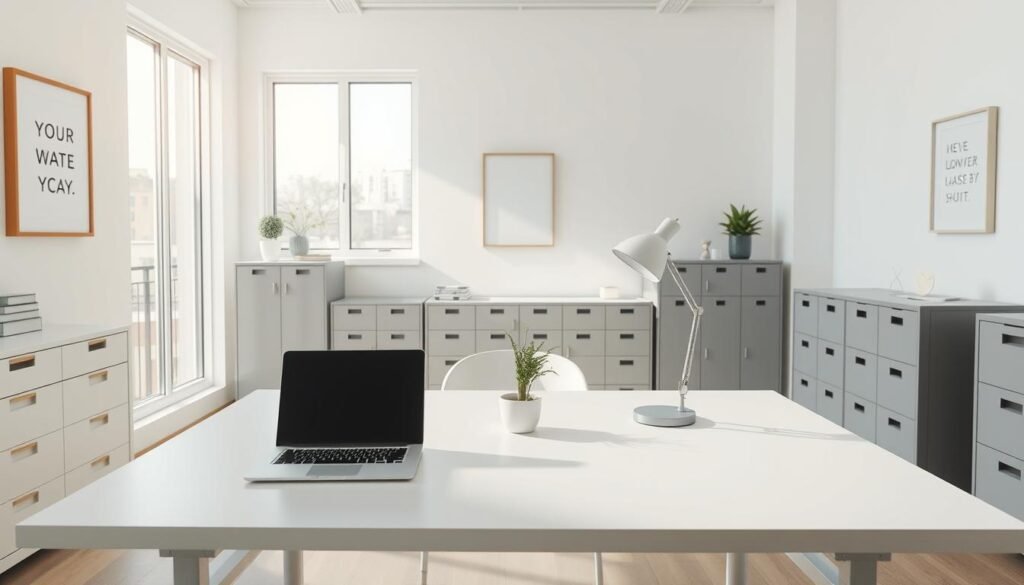A cluttered workspace can significantly impact productivity, with studies suggesting that a disorganized desk can lead to lost time, decreased focus, and increased stress levels. In today’s fast-paced work environment, maintaining a clutter-free desk is crucial for achieving success.
Reclaim your workspace and boost your focus with our comprehensive guide on decluttering your office. This article will walk you through practical steps to transform your workspace into an organized, efficient, and productive environment.
Key Takeaways
- Simple steps to declutter your office workspace
- Strategies for maintaining a clutter-free desk
- Benefits of an organized workspace for productivity
- Practical tips for organizing your office supplies
- Techniques for creating a productive work environment
Why Declutter Your Office Space?
Creating a clutter-free workspace is essential for improving your work quality and reducing stress. A cluttered office can feel chaotic and stressful, potentially lowering your productivity and effectiveness.
Let’s explore the benefits of maintaining a clean and organized workspace.
Benefits of a Clean Workspace
A clean workspace not only looks more professional but also has several operational benefits. It can enhance your reputation with clients and improve your overall work experience.
A well-organized office can lead to better time management and reduced time wasted searching for misplaced documents or supplies.
Improved Focus and Productivity
When your office is decluttered, you can focus better on your tasks. Clutter can be distracting, making it difficult to concentrate on the task at hand.
By implementing effective office organization strategies, you can significantly improve your productivity.
| Benefits | Cluttered Office | Organized Office |
|---|---|---|
| Productivity | Low | High |
| Stress Levels | High | Low |
| Time Management | Inefficient | Efficient |
Stress Reduction
A cluttered environment can contribute to increased stress levels. By decluttering your office, you can create a more peaceful and calming workspace.
Following office decluttering tips can help you achieve a stress-free work environment.
Assessing Your Current Office Setup
Assessing your office setup is the first step towards creating a clutter-free workspace. This process involves taking a close look at your current environment to identify areas that need improvement.
To start, take a moment to observe your office. Notice the areas that are cluttered or disorganized. It’s common to keep items without even realizing what we’re holding onto. The first step in any decluttering project is to throw out trash.
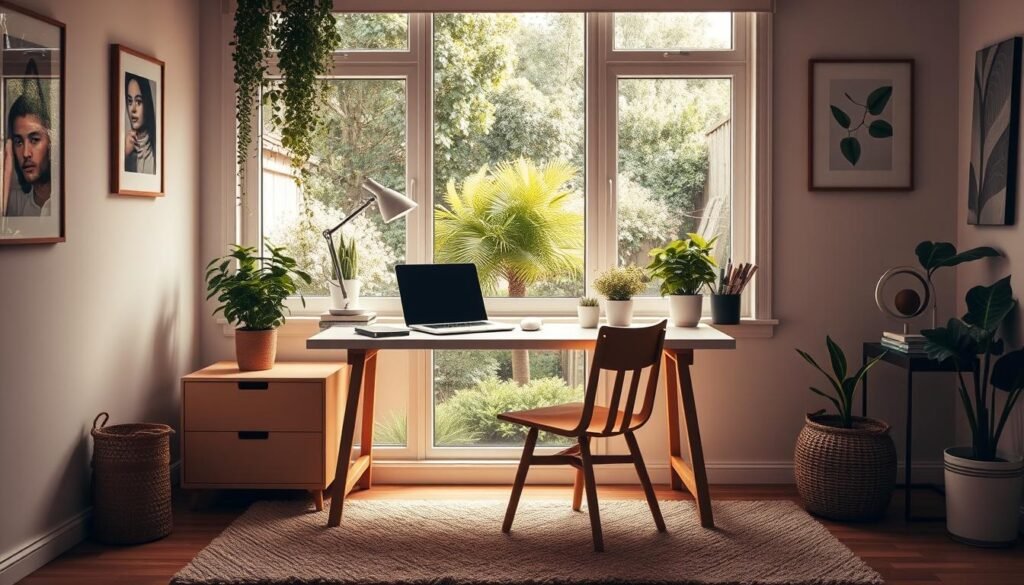
Identifying Clutter Hotspots
Clutter hotspots are areas where clutter tends to accumulate. In a home office, these might include your desk, filing cabinets, or storage areas. Make a mental note or write down the specific areas that need attention.
Common clutter hotspots include:
- Piles of paperwork or documents
- Stacks of unused office supplies
- Cables and cords
- Old equipment or broken items
Evaluating Your Needs
Once you’ve identified clutter hotspots, it’s time to evaluate your needs. Consider what you need to stay organized and productive. Think about the types of tasks you perform regularly and the tools you need to accomplish them.
Ask yourself:
- What are my most frequently used office supplies?
- Do I have enough storage for my documents and office materials?
- Are there any specific organizational tools that would help me stay on top of my work?
By assessing your current office setup, identifying clutter hotspots, and evaluating your needs, you’ll be well on your way to creating a more organized and productive home office.
Creating a Decluttering Plan
Creating a decluttering plan is the first step towards transforming your workspace into a minimalist office setup. This involves assessing your current office condition and devising a strategy to achieve your decluttering goals.
A well-structured plan helps in maintaining focus and ensures that the decluttering process is carried out efficiently. It’s about breaking down the task into manageable chunks and tackling them systematically.
Setting a Timeline
Setting a realistic timeline is crucial for the success of your decluttering plan. It’s essential to determine how much time you can dedicate to decluttering each day or week. Start by identifying the most cluttered areas and allocate specific timeslots for tackling them.
For instance, you might decide to dedicate 30 minutes each morning to decluttering or set aside a few hours on the weekend. The key is to be consistent and make steady progress.
Prioritizing Tasks
Prioritizing tasks is another vital aspect of your decluttering plan. Begin by making a list of all the tasks involved, such as sorting papers, organizing office supplies, and managing digital files. Then, rank these tasks based on their importance and urgency.
Ask yourself, “Does this task take less than 15 minutes to complete?” If the answer is no, consider breaking it down into smaller, more manageable tasks. This approach makes the decluttering process less overwhelming and more achievable.
Tips for Sorting Through Clutter
To start decluttering, you’ll need to sort through the clutter, deciding what to keep, what to toss, and what to donate. This process can seem overwhelming, but breaking it down into manageable steps makes it more achievable.
Keep, Toss, or Donate: The Decision-Making Process
When sorting through your office clutter, it’s helpful to create three piles: keep, archive, and junk. The items in the “keep” pile should include things you’ll need for daily and weekly work. Be ruthless – if you haven’t used it in the past year, it’s likely you won’t miss it.
Consider the following when deciding what to keep:
- Essential documents and files
- Frequently used office supplies
- Equipment and furniture in good condition
For items that are still useful but not immediately needed, consider archiving them. This could include storing less frequently used documents or seasonal decorations.
The One-Year Rule
A useful guideline for decluttering is the one-year rule: if you haven’t used something in a year, it’s probably safe to get rid of it. This rule helps simplify the decision-making process and ensures your workspace remains clutter-free.
“The secret to a clutter-free office is not just about getting rid of things, but about maintaining a system that keeps clutter at bay.”
To illustrate the effectiveness of the one-year rule, consider the following table:
| Item Category | Last Used | Decision |
|---|---|---|
| Office Supplies | 6 months ago | Keep |
| Documents | 2 years ago | Archive or Shred |
| Equipment | 1 year ago | Keep or Donate |
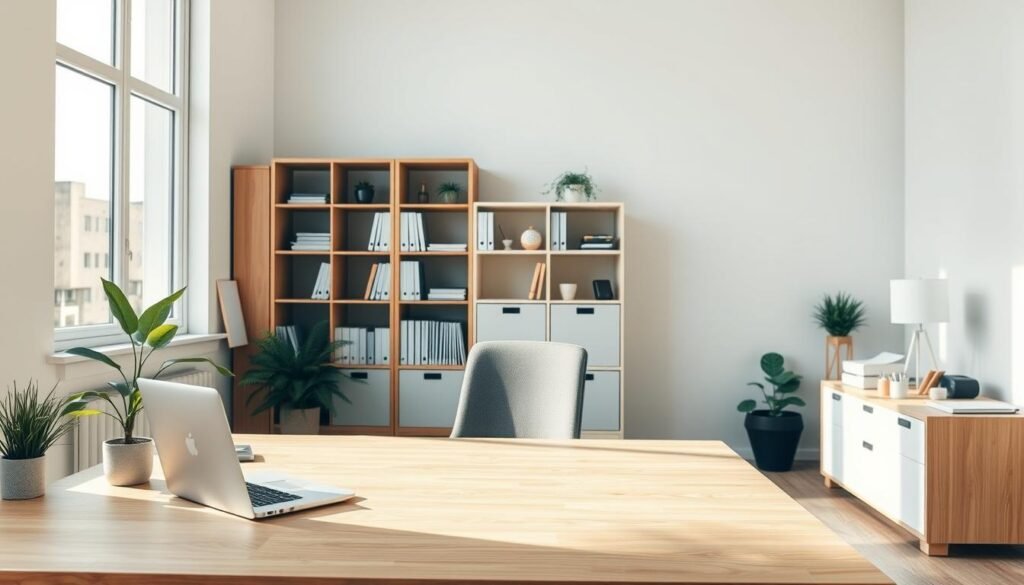
By applying these tips and maintaining a consistent decluttering routine, you can achieve and maintain a clutter-free workspace that enhances your productivity and focus.
Organizing Your Office Supplies
To maintain a tidy home office, it’s essential to organize your office supplies effectively. A well-organized supply system not only enhances your workspace’s aesthetics but also boosts your productivity by ensuring that everything you need is readily accessible.
Choosing the Right Storage Solutions
Selecting the appropriate storage solutions is a critical step in organizing your office supplies. Consider using dividers and shelves to keep your supplies in order. For instance, hanging shelves can be particularly useful for storing binders, manuals, and other paperwork, keeping them off your desk and out of the way.
Categorizing Items
Categorizing your office supplies is another vital aspect of maintaining a tidy home office. Start by grouping similar items together, such as pens, papers, and folders. This makes it easier to locate what you need when you need it. You can use storage bins or desk organizers to keep these categories separate and organized.
For example, you can have a specific drawer or container for office supplies like pens, pencils, and highlighters. Similarly, you can designate a particular area for storing important documents and papers. By categorizing and storing your supplies in this manner, you’ll be able to maintain a clutter-free workspace.
Digital Decluttering: Desktop Edition
A cluttered digital desktop can hinder productivity and increase stress, making it crucial to implement effective digital decluttering strategies. As we increasingly rely on digital tools for work and communication, organizing our digital space has become essential.
Organizing Digital Files
Organizing digital files is a critical step in digital decluttering. Start by creating clear and descriptive folders and subfolders. This will help you categorize your files into relevant groups, making it easier to locate specific documents.
- Create main folders for broad categories (e.g., Work, Personal, Projects).
- Use subfolders to further categorize files within these categories.
- Use clear and descriptive file names to avoid confusion.
Consider implementing a consistent naming convention for your files and folders to enhance organization.
Managing Emails
Managing emails effectively is another crucial aspect of digital decluttering. Unchecked, emails can quickly clutter your inbox, making it difficult to find important messages.
- Set up filters to automatically sort incoming emails into designated folders.
- Unsubscribe from newsletters and promotional emails that you no longer read.
- Use the “2-minute rule” – if an email can be dealt with in less than 2 minutes, respond or take action immediately.
Regularly cleaning out your inbox and keeping it organized can significantly reduce digital clutter.
Storing contacts and tasks digitally can also help reduce physical clutter. Using a simple Contacts program and Tasks program can remove 95-100% of the notes cluttering your workspace. Consider the following benefits:
| Digital Tool | Benefits |
|---|---|
| Contacts Program | Centralized contact information, easy access, and reduced paper clutter. |
| Tasks Program | Organized task management, reminders, and prioritization. |
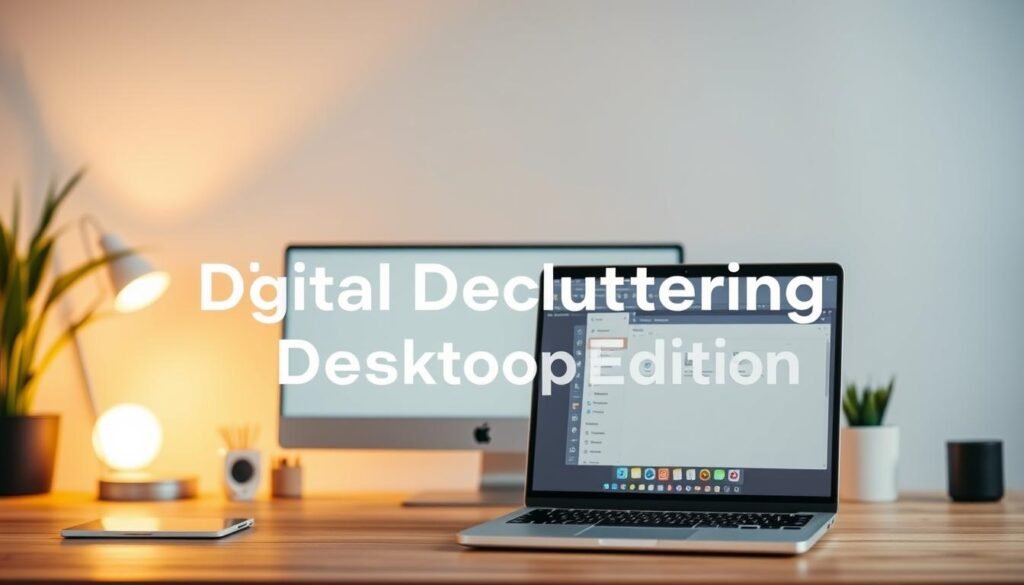
By implementing these digital decluttering strategies, you can create a more organized and efficient workspace, both physically and digitally.
Maintaining a Clutter-Free Desk
After decluttering, the real challenge begins: maintaining your newly organized workspace. Keeping your desk clutter-free is an ongoing process that requires some effort, but with the right habits, it can become second nature.
Daily Habits for Cleanliness
To keep your office organization on track, adopting daily habits is crucial. After using your desk each day, take a few minutes to put items back in their designated spots. This simple habit can significantly reduce clutter buildup over time.
- Clear your desk at the end of each day to start fresh the next morning.
- File away documents and papers immediately after use.
- Return office supplies to their designated storage areas.
Weekly Review Routine
In addition to daily habits, a weekly review routine can help maintain your clutter-free desk. Set aside some time each week to review your workspace, ensuring everything is in order and addressing any clutter that may have accumulated.
Key actions for your weekly review include:
- Checking for any new clutter or disorganization.
- Reorganizing storage solutions as needed.
- Updating your task lists and calendars.
By incorporating these daily habits and a weekly review routine into your office routine, you’ll be able to maintain a clutter-free desk and enjoy the benefits of a well-organized workspace.
Utilizing Minimalism in Your Office
A minimalist office setup is not just about aesthetics; it’s a pathway to a more organized and efficient work environment. By embracing minimalism, you can significantly reduce distractions and improve your focus on tasks.
Why Less is More
Minimalism in the office is about more than just having fewer items; it’s about creating a workspace that is conducive to productivity and creativity. A clutter-free desk grants freedom to pursue the project of your choosing, unencumbered by the folders and papers that once held your attention captive.
The Benefits of a Minimalist Office:
- Increased productivity due to reduced distractions
- Improved focus on tasks at hand
- A more organized and efficient work environment
- Enhanced creativity in a clutter-free space
Incorporating Minimalist Design
Incorporating minimalist design into your office involves more than just decluttering; it’s about creating a harmonious and functional space. This can be achieved by selecting a few key pieces of furniture and decor that serve both functional and aesthetic purposes.
Consider the following elements when designing your minimalist office:
| Element | Description | Benefit |
|---|---|---|
| Simple Furniture | Clean-lined, multi-functional pieces | Reduces clutter, enhances functionality |
| Minimal Decor | A few, carefully chosen decorative items | Maintains focus, adds aesthetic appeal |
| Organized Storage | Efficient storage solutions for necessary items | Keeps workspace clear, reduces stress |
By thoughtfully incorporating these elements, you can create a workspace that is both beautiful and functional, embodying the principles of minimalism.
Accessories for a Tidy Office
Office accessories play a crucial role in maintaining a tidy and organized workspace, enhancing productivity and focus. The right accessories can help keep your office supplies and documents in order, making it easier to work efficiently.
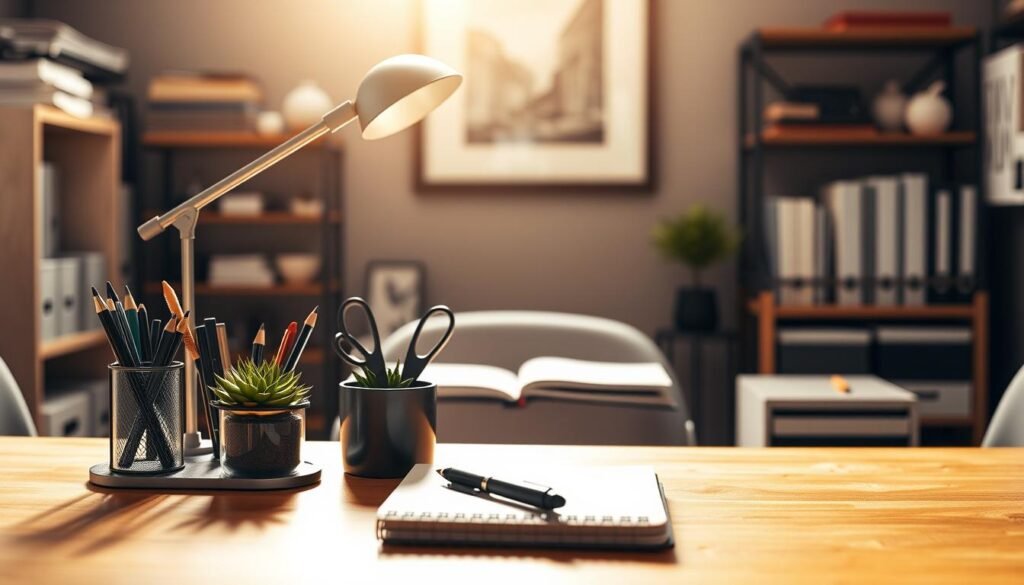
Must-Have Organization Tools
To maintain a clutter-free office, it’s essential to have the right organization tools. Using drawers isn’t cheating; it’s smart. It keeps your projects, tools, and supplies at your fingertips while still removing them from your line of sight.
- Desk organizers for pens, papers, and office supplies
- File cabinets for storing important documents
- Drawer dividers to keep supplies organized
- Cable management systems to keep cords tidy
These tools help in keeping your workspace organized and clutter-free, allowing you to focus on your work.
Decorative yet Functional Items
In addition to organization tools, incorporating decorative yet functional items can enhance your workspace. These items not only add aesthetic value but also contribute to a more organized and productive environment.
“A place for everything, and everything in its place.” – Benjamin Franklin
Some examples include:
| Item | Function | Aesthetic Value |
|---|---|---|
| Artistic desk lamps | Provide lighting | Add a touch of elegance |
| Plants | Purify the air | Enhance the office ambiance |
| Colorful file folders | Organize documents | Add a pop of color |
By incorporating these accessories, you can create a workspace that is both functional and visually appealing, promoting a productive work environment.
Involving Others in the Decluttering Process
Organizing your office space is more manageable when you involve others in the process. Whether you work in a shared office environment or have a home office, having others help with decluttering can make the task less daunting and more efficient.
Team Up with Colleagues
If you work in an office with coworkers, consider teaming up to declutter your shared workspace. This can be a great opportunity to bond with colleagues and create a more productive work environment. You can work together to sort through clutter, assign tasks, and implement a system for maintaining a tidy office. Additionally, hiring professional janitorial cleaning services can help keep the entire facility organized and promote better productivity.
Family Involvement for Home Offices
For those with home offices, involving family members in the decluttering process can be beneficial. Assign tasks to each family member to make it a fun, collaborative effort. This not only helps to declutter your workspace but also teaches children the importance of maintaining a tidy home office. By working together, you can create a more organized and peaceful work environment.
Celebrating Your Clutter-Free Office
Achieving a clutter-free office is a significant accomplishment, and it’s essential to acknowledge your hard work. By decluttering your office, you’ve taken a crucial step towards improving your productivity and reducing stress. Now, it’s time to enjoy the benefits of your newly organized workspace.
Achieving Milestones
Reward yourself for your efforts in decluttering your office. You can treat yourself to a favorite meal or activity, or simply take a moment to appreciate the calm atmosphere you’ve created. This will help motivate you to maintain your newly organized office.
Sharing Your Success
Share your experience with colleagues or friends who may be struggling with their own office organization. You can also share your favorite decluttering tips on social media, inspiring others to tackle their clutter. By sharing your success, you’ll not only be helping others but also reinforcing your own progress in maintaining a clutter-free office.
Maintaining a decluttering routine, even if it’s just 15 minutes a day, will help you see lasting results in your office organization. By incorporating decluttering into your daily habits, you’ll be able to enjoy the benefits of a clutter-free workspace for a long time.
FAQ
How do I start decluttering my office?
What is the one-year rule in decluttering?
How can I maintain a clutter-free desk?
What are some benefits of a minimalist office setup?
How can I involve others in the decluttering process?
What are some must-have organization tools for a tidy office?
How can I organize my digital files and emails?
What are some tips for sorting through clutter?
How can I keep my office supplies organized?
Prabir Dutta
Prabir Dutta is a passionate digital creator, affiliate marketer, and wellness enthusiast who simplifies complex topics like AI tools, Vastu, pet care, and modern living. With a keen eye for SEO, tech trends, and everyday health solutions, he writes to empower readers with actionable, smart-living insights. When not curating content across his network of niche blogs, Prabir enjoys exploring new digital tools that make life easier and more efficient.

